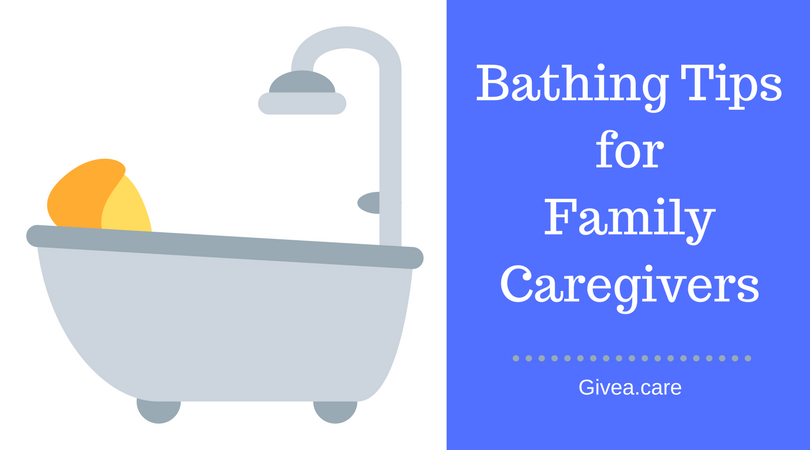Bathing Tips for Family Caregivers
Bathing or showering is a feat all it’s own when it comes to someone who cannot readily get around, move or wash themselves. The right equipment, schedule, and know-how can alleviate a ton of bath time stress, however – here are some best practices and bathing tips we’ve picked up over the years:

- Bathe 1 – 2 times a week: Unless the person you are caring for is out exercising every day and sweating a lot, chances are multiple baths a week are overkill. We used to bathe Mom once a week and tried to maintain a regular schedule so it typically happened the same day of the week (though that wasn’t always possible). Once, she went into the hospital for 10 days and ended up with a central line (and IV in her chest) and was on IV antibiotics when she got home for another two weeks so she virtually didn’t have a bath for a month. It happens people, and it doesn’t make you a bad caregiver. Just remember, if you think they smell, imagine what they’re thinking. So that brings us to . . .
- “Cat bath” in between showers: Toddler wipes or adult washcloths can be found in virtually any pharmacy or grocery store. On those days in between showers, do a quick wipe down of the full body, put on deodorant and spritz a little perfume or cologne to help your loved one feel fresh and clean. We’ve tried the “dry shampoo” thing when it was a fad and didn’t find it particularly helpful, but remember that option too in case it is something that works for your loved one in between bath days.
- Get a shower head with removable nozzle: We’ve had the most luck finding shower heads at stores like Lowes or Home Depot. A shower head that comes off its base with a bendable chord that is at least 5 feet long is typically the ticket, allowing plenty of slack for moving the shower head over and around the person you’re bathing. It should be pretty easy to unscrew your current shower head and screw a new one on, so don’t worry about installation unless you have some custom fancy pants shower. In that case, call an expert.
- Get a shower/bath chair with side rail: Once getting up and down alone is out of the picture for the person you care for, a must-have piece of equipment is a shower chair (typically with a rail for added support). You can find them online or at the pharmacy, you don’t need a prescription, they’ll just be in the aisle typically with other senior things like adult diapers and pillboxes. BEFORE you buy, take a quick inventory of which side of your shower the shower head is on and facing – this will affect the type of chair you decide to buy. Specialty shower chairs you find online or with equipment companies might even feature transfer/sliding seats to make the getting in and out of a tub shower even easier.
- Get a shower cushion/pillow: Those plastic, water-resistant shower chairs are not comfy so definitely invest in a waterproof shower cushion for your loved one to sit on. These plastic pillows tend to slide forward on the shower chair if the person you’re bathing leans back at all, so in our case, we simply took a couple pieces of string and tied it to the two back poles to help it stay in place. These types of cushions are super important especially for people with bed sores on their bottom or who have hip/back issues. Bed and bath stores also sell plush, softer pillows for taking luxurious baths and these work well when tied to the back portion of a shower chair to cushion your loved one’s spine when sitting in the shower.
- Ask for help: When it comes to baths, two people helping is definitely better than one. One person to stand and help your loved one stay up, balanced, rinse them, and hold the showerhead when your hands are full. And another person to do the washing, scrubbing, rinsing and also help keep your loved one balanced. Trust me, not only are two people more efficient, it is also safer for you and the person you’re caring for. Preventing falls is a huge part of caregiving for many people, and the bath can be a dangerous place.
In our case, Mom was comfortable with two people like me and my sister or my husband and I bathing her (her brain was in more of a child-state), but I know for many caregivers, your parent(s) may not be comfortable being naked in front of you or anyone else and could even put off bathing altogether. In these cases, I’ve seen helpful outlets like AgingCare.com sharing tips like figuring out why your loved one is letting hygiene slip, consulting a doctor for help, and revamping the bathroom for comfort and safety.
I hope these bathing tips help you and your loved one! If you need help getting equipment for bathing your loved one, like shower chairs, see if your local Council on Aging or Christian ministry has a lending library. After Mom passed away, we found several nonprofits to donate her gently used medical equipment to including shower chairs, bedside commodes, wheelchairs, etc. You may be able to find the equipment your loved one needs for free!

